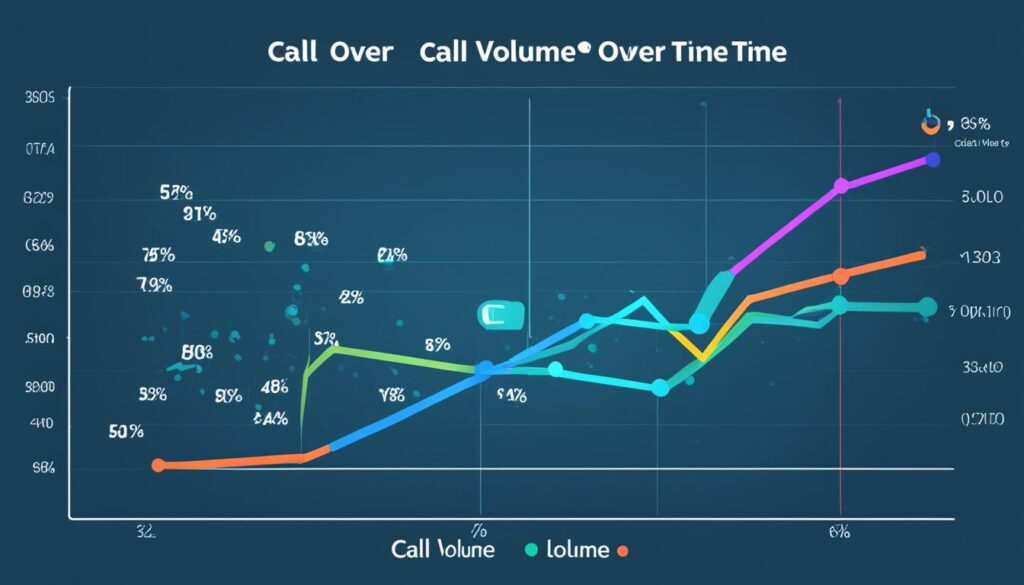Boost Your Call Center Productivity Today!

Are you looking to improve the efficiency and effectiveness of your call center operations? Do you want to optimize your resources and increase customer service productivity? If so, then it’s time to explore strategies for boosting call center productivity. In this article, we will delve into the key factors that contribute to call center productivity and provide actionable tips to help you optimize your operations. Are you ready to take your call center performance to new heights?
Key Takeaways:
- Employee productivity is crucial for overall call center success.
- Metrics such as average handle time and customer satisfaction can help measure call center productivity.
- Increasing agent motivation and providing the right tools are essential for enhancing productivity.
- Moving to cloud-based solutions and continuous training can significantly improve call center efficiency.
- A positive work environment and recognition play a vital role in boosting call center effectiveness.
Understanding Call Center Productivity
Call center productivity is a critical factor in the success of any contact center. It measures how efficiently a call center utilizes its resources to assist customers, ensuring the best possible service delivery. At the heart of call center productivity lies agent productivity, which is directly influenced by agent motivation and the tools and environment they work in.
When it comes to measuring call center productivity, several metrics play a crucial role in assessing agent and overall call center performance. These metrics include average handle time, first-call resolution rate, and customer satisfaction score. Average handle time measures the average duration of calls, while the first-call resolution rate looks at the percentage of requests resolved during the initial interaction. The customer satisfaction score indicates how satisfied customers are with the service they receive. By tracking these metrics, call centers can gain valuable insights into their performance and identify areas for improvement.
To enhance call center productivity, creating a positive work environment is key. A supportive and motivating work environment can significantly impact agent morale, leading to increased productivity. Additionally, implementing effective training programs equips agents with the necessary skills and knowledge to handle customer inquiries efficiently.
Furthermore, leveraging AI technology to automate manual tasks and streamline processes can boost call center productivity. AI-powered solutions can handle routine and repetitive tasks, allowing agents to focus on more complex customer inquiries. By reducing manual workload and enhancing efficiency, call centers can optimize their operations and deliver exceptional customer service.
In conclusion, understanding call center productivity is essential for establishing efficient and effective contact center operations. By prioritizing agent productivity, implementing metrics to measure performance, fostering a positive work environment, providing effective training programs, and leveraging AI technology, call centers can enhance their productivity, drive customer satisfaction, and achieve their business goals.
Metrics for Measuring Call Center Productivity
To effectively measure call center productivity, several key metrics are used. These metrics provide valuable insights into agent performance and overall call center efficiency. By tracking and analyzing these metrics, call centers can identify areas for improvement and make data-driven decisions to enhance their operations.
1. Average Handle Time
The average handle time (AHT) is a crucial metric that measures the average duration of each call. It includes the time an agent spends actively engaged with a customer, handling their query or resolving their issue. A low AHT indicates efficient call handling and can contribute to higher productivity.
2. First-Call Resolution Rate
The first-call resolution (FCR) rate measures the percentage of customer inquiries or issues that are resolved during the initial call. A high FCR rate indicates that agents have the knowledge and tools to effectively address customer concerns, reducing the need for follow-up calls and enhancing customer satisfaction.
3. Call Abandonment Rate
The call abandonment rate measures the percentage of calls that are abandoned or disconnected by customers before they can be answered by an agent. A high call abandonment rate can indicate long wait times or inefficient call routing, highlighting areas that require improvement to prevent customer frustration and potential revenue loss.
4. Service Level
The service level metric tracks the percentage of calls answered within a specified time frame, typically measured in seconds. It reflects the call center’s commitment to providing prompt and efficient customer service. A higher service level indicates that calls are being answered quickly, leading to improved customer satisfaction.
5. Customer Satisfaction Score
The customer satisfaction score (CSAT) measures the level of customer satisfaction with the service they received during their interaction with the call center. It is usually determined through post-call surveys or feedback. A high CSAT score indicates a positive customer experience, reflecting effective call center operations and agent performance.
By regularly monitoring and analyzing these call center productivity metrics, organizations can identify trends, set benchmarks, and make informed decisions to optimize agent performance and enhance overall call center efficiency.
| Metric | Description |
|---|---|
| Average Handle Time (AHT) | The average duration of each call, measuring agent efficiency. |
| First-Call Resolution (FCR) Rate | The percentage of customer inquiries resolved during the initial call, reflecting agent effectiveness. |
| Call Abandonment Rate | The percentage of calls abandoned by customers before being answered, indicating potential issues with wait times or call routing. |
| Service Level | The percentage of calls answered within a specified timeframe, demonstrating call center responsiveness. |
| Customer Satisfaction Score (CSAT) | The level of customer satisfaction with the service provided, reflecting overall call center performance. |
Image:

Tips for Increasing Call Center Efficiency
To increase call center efficiency and improve overall performance, it’s important to implement effective strategies and tactics. By optimizing various aspects of your call center operations, you can enhance productivity, reduce turnover, and maximize individual efficiency.
One key factor in improving call center efficiency is reducing turnover. High turnover can have a significant negative impact on productivity and customer service. To address this, monitor employee engagement closely, provide ongoing coaching and training, and encourage open communication. By nurturing a positive and supportive work environment, you can retain a stable and motivated team.
Optimizing individual efficiency is another crucial aspect of increasing call center efficiency. Providing agents with enough refresh time helps prevent burnout and allows them to perform their tasks more effectively. Additionally, equipping agents with the best technology and tools available streamlines their workflows and enhances their productivity.
Measuring and monitoring relevant metrics is essential to track call center efficiency. Set clear performance goals and make them transparent to your team. Regularly measure metrics such as average handle time, first-call resolution rate, call abandonment rate, and customer satisfaction score. These metrics provide insights into individual and overall call center performance, allowing you to identify areas for improvement.
Increase your call center efficiency even further by utilizing the best technology and software solutions. Implementing advanced workforce management systems, customer relationship management (CRM) software, and artificial intelligence (AI) tools can automate processes, streamline workflows, and optimize resource allocation.
Create a stimulating and enjoyable work environment by fostering a positive company culture. Recognize and reward your employees for their achievements and contributions. Encourage collaboration, provide opportunities for growth and development, and prioritize employee well-being. A motivated and engaged workforce leads to increased productivity and improved call center efficiency.
By implementing these tips and strategies, you can optimize your call center operations, enhance productivity, and ultimately improve customer service.

Improving Contact Center Efficiency with Cloud-Based Solutions
Looking to increase your contact center’s efficiency? Consider adopting cloud-based call center solutions, specifically hosted unified communications. By embracing these cutting-edge technologies, you can revolutionize your work infrastructure and enhance the overall efficiency of your call center operations.
Cloud-based call center solutions offer several advantages that can drive productivity and improve customer service. One of the key benefits is scalability, allowing your business to easily expand or downsize without experiencing any downtime. Unlike traditional systems, cloud-based solutions don’t require hefty installation resource requirements, making it a cost-effective option for businesses of all sizes.
Another significant advantage of cloud-based call center solutions is the ability to enable remote working. With these solutions in place, agents can work from anywhere, increasing flexibility and enabling your call center to tap into a broader talent pool. By incorporating remote working options, you can attract and retain top-performing agents and improve overall call center efficiency.
Cloud-based solutions also offer a more modern and efficient infrastructure compared to traditional systems. With a consolidated platform, agents can access all the necessary tools and applications in one place, eliminating the need for multiple portals and simplifying processes. This streamlined approach not only saves time but also enhances productivity and boosts efficiency.
One popular cloud-based call center solution is Skype for Business, which can be adapted for customer representation. With features like call recording, smart agent selection, and interactive voice response, Skype for Business provides added benefits to enhance call center efficiency.
To further illustrate the benefits of cloud-based call center solutions, consider the following table:
| Advantages of Cloud-Based Call Center Solutions |
|---|
| Improved scalability for easy expansion or downsizing |
| Enable remote working for increased flexibility |
| Streamlined infrastructure, eliminating the need for multiple portals |
| Consolidated tools and applications for enhanced productivity |
| Features like call recording, smart agent selection, and interactive voice response |
By leveraging cloud-based call center solutions, you can transform your contact center into a highly efficient and productive operation. Embrace hosted unified communications and experience the power of improved work infrastructure, increased scalability, and the ability to enable remote working. Stay ahead of the competition and enhance your call center efficiency today!

Enhancing Efficiency Through Continuous Training
In order to maximize productivity and reduce skill-related losses, continuous training plays a crucial role in increasing call center efficiency. While most call centers provide front-end training, ongoing coaching and skill development are essential for agents to continually improve their performance and minimize mistakes. By addressing issues and providing immediate feedback, continuous training helps bridge skill gaps and elevates overall call center performance.
Continuous training provides agents with the opportunity to enhance their skills and knowledge, enabling them to handle customer queries more effectively and efficiently. Ongoing coaching sessions allow agents to receive personalized guidance and support, ensuring consistent development and growth.
By investing in continuous training programs, call centers can mitigate skill-related losses that may occur due to gaps in agent knowledge or changes in customer requirements. This proactive approach reduces the likelihood of mistakes and ensures a higher quality of service delivery.
Benefits of Continuous Training:
- Fosters ongoing skill development
- Reduces mistakes and errors
- Mitigates skill-related losses
- Enhances agent performance
- Maximizes call center productivity
With continuous training, agents have the opportunity to refine their competencies, stay updated with the latest industry trends, and learn new techniques to improve customer interactions. By continually investing in their skills, agents can provide a higher level of service, resulting in increased customer satisfaction and loyalty.
By implementing ongoing coaching and skill development programs, call centers can create a culture of continuous improvement. This not only boosts agent morale and satisfaction but also contributes to overall call center efficiency and effectiveness.
| Benefits of Continuous Training | Explanation |
|---|---|
| Enhanced Agent Performance | Continuous training helps agents improve their skills and knowledge, enabling them to handle customer queries more effectively. |
| Reduced Mistakes and Errors | Ongoing coaching reduces the likelihood of mistakes, ensuring a higher quality of service delivery. |
| Mitigated Skill-Related Losses | Continuous training minimizes skill gaps, reducing the risk of skill-related losses in call center operations. |
| Maximized Call Center Productivity | Agents’ continuous improvement leads to increased productivity, resulting in higher efficiency for the call center. |
Continuous training is an investment in both the individual agent’s development and the overall success of the call center. By prioritizing ongoing learning and skill enhancement, call centers can optimize their operations and deliver exceptional customer service.

The Importance of a Positive Work Environment and Recognition
Creating a positive work environment is crucial for enhancing call center efficiency. When employees feel valued, motivated, and supported, they are more likely to perform at their best and contribute to the overall success of the call center. A positive work environment not only improves employee morale but also increases productivity, improves employee retention, and fosters a culture of continuous improvement.
Effective Communication: Open and transparent communication is the foundation of a positive work environment. Encouraging employees to share their ideas, concerns, and feedback promotes a sense of belonging and inclusion. Implementing regular team meetings, one-on-one discussions, and communication tools can facilitate effective communication among team members and with management.
Show Appreciation: Recognizing and rewarding employees for their hard work, achievements, and contributions is essential for keeping them motivated. Expressing gratitude through simple gestures such as verbal appreciation, written notes, or public acknowledgments can boost morale and demonstrate that their efforts are valued and recognized.
Lead by Example: Leaders play a crucial role in creating a positive work environment. Leading by example, demonstrating positive behaviors, and maintaining a supportive and respectful attitude towards employees sets the tone for the entire call center. When leaders prioritize employee well-being and provide guidance and support, it inspires employees to excel in their roles.
Promote Work-Life Balance: Striking a balance between work and personal life is essential for employee satisfaction and well-being. Offering flexible scheduling options, promoting self-care and wellness initiatives, and providing opportunities for personal growth and development can help employees achieve a healthy work-life balance, reducing stress and burnout.
Recognize and Reward: Recognizing and rewarding employees for their efforts, achievements, and milestones is a powerful way to motivate and inspire them. This can be done through various means such as performance-based bonuses, employee of the month programs, or team-based incentives. Recognizing exceptional performance not only boosts employee morale but also encourages others to strive for excellence.
Stimulating Work Environment: Creating a work environment that is stimulating, engaging, and fosters creativity can significantly enhance call center efficiency. Providing opportunities for skill development, offering challenging projects, and embracing innovation can empower employees and make their work more fulfilling and rewarding.
By prioritizing a positive work environment and recognizing the efforts of employees, call centers can motivate their team, increase productivity, and improve employee retention. When employees feel valued and supported, they are more likely to go above and beyond to deliver outstanding customer service and contribute to the overall success of the call center.
Conclusion
Call center productivity is an essential factor in the success of any organization. By adopting a holistic approach that focuses on agent performance, metrics measurement, technology adoption, training, and creating a positive work environment, call centers can significantly boost their efficiency and optimize operations.
Increasing efficiency and optimizing operations not only lead to cost savings but also enable call centers to deliver enhanced customer service. By improving agent productivity and utilizing the right tools and technology, call centers can drive profitability and achieve their business goals.
Continuously improving call center productivity is the key to transforming a call center into a high-performing and successful operation. By committing to productivity and embracing continuous improvement, call centers can enhance customer service, optimize operations, and ultimately drive profitability.






